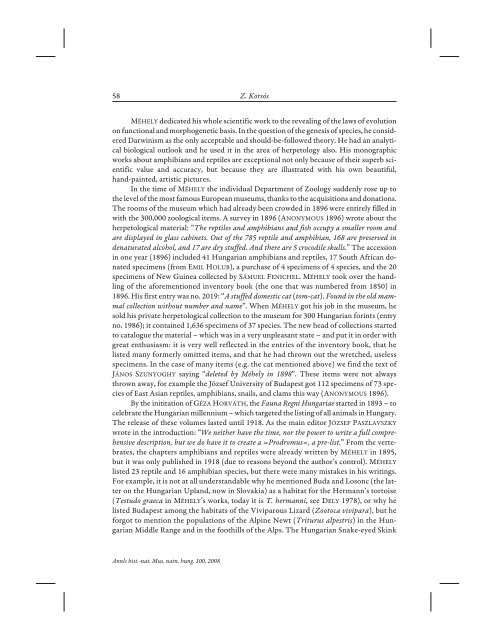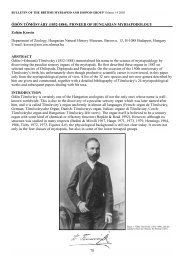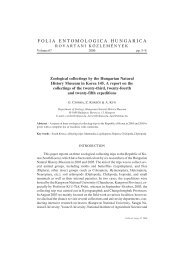History of the Herpetological Collection of the ... - Korsós Zoltán
History of the Herpetological Collection of the ... - Korsós Zoltán
History of the Herpetological Collection of the ... - Korsós Zoltán
Create successful ePaper yourself
Turn your PDF publications into a flip-book with our unique Google optimized e-Paper software.
58 Z. Korsós<br />
MÉHELY dedicated his whole scientific work to <strong>the</strong> revealing <strong>of</strong> <strong>the</strong> laws <strong>of</strong> evolution<br />
on functional and morphogenetic basis. In <strong>the</strong> question <strong>of</strong> <strong>the</strong> genesis <strong>of</strong> species, he considered<br />
Darwinism as <strong>the</strong> only acceptable and should-be-followed <strong>the</strong>ory. He had an analytical<br />
biological outlook and he used it in <strong>the</strong> area <strong>of</strong> herpetology also. His monographic<br />
works about amphibians and reptiles are exceptional not only because <strong>of</strong> <strong>the</strong>ir superb scientific<br />
value and accuracy, but because <strong>the</strong>y are illustrated with his own beautiful,<br />
hand-painted, artistic pictures.<br />
In <strong>the</strong> time <strong>of</strong> MÉHELY <strong>the</strong> individual Department <strong>of</strong> Zoology suddenly rose up to<br />
<strong>the</strong> level <strong>of</strong> <strong>the</strong> most famous European museums, thanks to <strong>the</strong> acquisitions and donations.<br />
The rooms <strong>of</strong> <strong>the</strong> museum which had already been crowded in 1896 were entirely filled in<br />
with <strong>the</strong> 300,000 zoological items. A survey in 1896 (ANONYMOUS 1896) wrote about <strong>the</strong><br />
herpetological material: “The reptiles and amphibians and fish occupy a smaller room and<br />
are displayed in glass cabinets. Out <strong>of</strong> <strong>the</strong> 785 reptile and amphibian, 168 are preserved in<br />
denaturated alcohol, and 17 are dry stuffed. And <strong>the</strong>re are 5 crocodile skulls.” The accession<br />
in one year (1896) included 41 Hungarian amphibians and reptiles, 17 South African donated<br />
specimens (from EMIL HOLUB), a purchase <strong>of</strong> 4 specimens <strong>of</strong> 4 species, and <strong>the</strong> 20<br />
specimens <strong>of</strong> New Guinea collected by SÁMUEL FENICHEL. MÉHELY took over <strong>the</strong> handling<br />
<strong>of</strong> <strong>the</strong> aforementioned inventory book (<strong>the</strong> one that was numbered from 1850) in<br />
1896. His first entry was no. 2019: “A stuffed domestic cat (tom-cat). Found in <strong>the</strong> old mammal<br />
collection without number and name”. When MÉHELY got his job in <strong>the</strong> museum, he<br />
sold his private herpetological collection to <strong>the</strong> museum for 300 Hungarian forints (entry<br />
no. 1986); it contained 1,636 specimens <strong>of</strong> 37 species. The new head <strong>of</strong> collections started<br />
to catalogue <strong>the</strong> material – which was in a very unpleasant state – and put it in order with<br />
great enthusiasm: it is very well reflected in <strong>the</strong> entries <strong>of</strong> <strong>the</strong> inventory book, that he<br />
listed many formerly omitted items, and that he had thrown out <strong>the</strong> wretched, useless<br />
specimens. In <strong>the</strong> case <strong>of</strong> many items (e.g. <strong>the</strong> cat mentioned above) we find <strong>the</strong> text <strong>of</strong><br />
JÁNOS SZUNYOGHY saying “deleted by Méhely in 1898”. These items were not always<br />
thrown away, for example <strong>the</strong> József University <strong>of</strong> Budapest got 112 specimens <strong>of</strong> 73 species<br />
<strong>of</strong> East Asian reptiles, amphibians, snails, and clams this way (ANONYMOUS 1896).<br />
By <strong>the</strong> inititation <strong>of</strong> GÉZA HORVÁTH,<strong>the</strong>Fauna Regni Hungariae started in 1893 – to<br />
celebrate <strong>the</strong> Hungarian millennium – which targeted <strong>the</strong> listing <strong>of</strong> all animals in Hungary.<br />
The release <strong>of</strong> <strong>the</strong>se volumes lasted until 1918. As <strong>the</strong> main editor JÓZSEF PASZLAVSZKY<br />
wrote in <strong>the</strong> introduction: “We nei<strong>the</strong>r have <strong>the</strong> time, nor <strong>the</strong> power to write a full comprehensive<br />
description, but we do have it to create a »Prodromus«, a pre-list.” From <strong>the</strong> vertebrates,<br />
<strong>the</strong> chapters amphibians and reptiles were already written by MÉHELY in 1895,<br />
but it was only published in 1918 (due to reasons beyond <strong>the</strong> author’s control). MÉHELY<br />
listed 23 reptile and 16 amphibian species, but <strong>the</strong>re were many mistakes in his writings.<br />
For example, it is not at all understandable why he mentioned Buda and Losonc (<strong>the</strong> latter<br />
on <strong>the</strong> Hungarian Upland, now in Slovakia) as a habitat for <strong>the</strong> Hermann’s tortoise<br />
(Testudo graeca in MÉHELY’s works, today it is T. hermanni, see DELY 1978), or why he<br />
listed Budapest among <strong>the</strong> habitats <strong>of</strong> <strong>the</strong> Viviparous Lizard (Zootoca vivipara), but he<br />
forgot to mention <strong>the</strong> populations <strong>of</strong> <strong>the</strong> Alpine Newt (Triturus alpestris) in<strong>the</strong>Hungarian<br />
Middle Range and in <strong>the</strong> foothills <strong>of</strong> <strong>the</strong> Alps. The Hungarian Snake-eyed Skink<br />
Annls hist.-nat. Mus. natn. hung. 100, 2008




